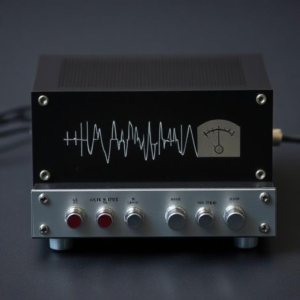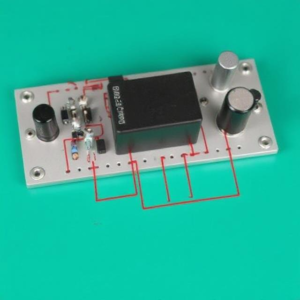An Operational Amplifier (Op-Amp) is a special type of electronic component that works like a super-powerful, super-sensitive amplifier for electrical signals. You can think of it as a kind of “signal booster” that makes small electrical signals much stronger.
Here’s an easy way to understand it:
- Two Inputs, One Output: An Op-Amp has two input pins (called the “+” and “−” inputs), and one output pin.
- The “+” (non-inverting) input: The signal that is applied here will be amplified and come out as a bigger version of the signal.
- The “−” (inverting) input: This input can flip the signal upside down (invert it) and then amplify it.
- Amplifying the Difference: The Op-Amp amplifies the difference between the two inputs. So, if the “+” input is slightly higher than the “−” input, the Op-Amp will produce a large output that is based on that difference.
- Super Sensitive: Even tiny differences in the input voltages can cause a big change in the output. It’s like a super-sensitive microphone that can pick up even the slightest sound.
- Uses in Circuits: Op-Amps are used in many different types of circuits:
- Amplifiers: Boost weak signals to be stronger.
- Comparators: Compare two voltages and decide which one is larger.
- Filters: Help eliminate unwanted parts of a signal.
- Integrators/Differentiators: Perform mathematical operations like adding or subtracting signals.
Basic Structure of an Op-Amp:

- Inputs:
- Non-Inverting Input (+): This is the input where the signal is applied and not inverted. The voltage at this input is directly amplified.
- Inverting Input (−): This is where the signal is inverted, meaning if the voltage at this input increases, the output voltage will decrease.
- Output: The Op-Amp provides an amplified version of the difference between the voltages at the two inputs. The output can swing between the supply voltages, typically represented as V+ (positive supply) and V− (negative supply).
- Power Supply: An Op-Amp requires a power supply, usually a dual voltage (positive and negative) to function. For example, a ±15V power supply is common.
Ideal Op-Amp:
In an ideal Op-Amp:
- Infinite open-loop gain (i.e., any tiny difference between the inputs is amplified immensely).
- Infinite input impedance (so that it doesn’t draw current from the source).
- Zero output impedance (so it can drive any load easily).
- Infinite bandwidth (it can amplify signals of any frequency).
- Zero offset voltage (no difference between the inputs when there should be none).
However, in real-life applications, no Op-Amp is “ideal.” Practical Op-Amps have limitations like finite gain, bandwidth, and input/output impedance.
How Does an Op-Amp Work?
An Op-Amp works by amplifying the difference between the voltages at its two inputs. The output is given by:
Where:
is the open-loop gain of the Op-Amp (typically very large).
and
are the voltages at the non-inverting and inverting inputs, respectively.
In practical applications, this output is often controlled by feedback, which stabilizes the operation of the Op-Amp and can dictate its behavior in different types of circuits.
Types of Op-Amp Circuits:
Op-Amps are used in various configurations depending on the application. The feedback (positive or negative) and external components (resistors, capacitors) dictate the circuit behavior. Here are some common types of Op-Amp circuits:
1. Inverting Amplifier:
- Configuration: The input signal is applied to the inverting input (−), and the non-inverting input (+) is grounded.
- Behavior: The output is an amplified version of the input signal, but inverted (i.e., the phase is flipped).
- Gain: The gain (amplification) is determined by the ratio of resistors in the circuit.
Where
is the feedback resistor and
is the input resistor.
2. Non-Inverting Amplifier:
- Configuration: The input signal is applied to the non-inverting input (+), while the inverting input (−) is connected to a resistor network.
- Behavior: The output is an amplified version of the input signal without any inversion.
- Gain: The gain is given by:
Where
is the feedback resistor and
is the resistor between the inverting input and ground.
3. Voltage Follower (Buffer Amplifier):
- Configuration: The output is directly connected to the inverting input, creating a unity gain amplifier (gain = 1).
- Behavior: The output follows the input voltage, meaning the output signal is the same as the input signal (no amplification), but with high input impedance and low output impedance.
- Applications: This circuit is used to buffer signals, providing impedance matching between stages of a circuit without altering the signal.
4. Differential Amplifier:
- Configuration: A differential amplifier takes two input signals and amplifies the difference between them.
- Behavior: The output is the difference between the voltages at the two inputs, scaled by a constant gain.
- Applications: This is useful for situations where you want to measure the difference between two signals, such as in instrumentation or sensor applications.
5. Integrating Amplifier:
- Configuration: The input signal is applied to the inverting input (−), and the feedback resistor is replaced with a capacitor.
- Behavior: This circuit produces an output that is the integral of the input signal, meaning it sums up the input over time.
- Applications: Used in signal processing, analog computing, and creating signals that change gradually over time.
6. Differentiating Amplifier:
- Configuration: The input signal is applied to the inverting input (−), and the feedback resistor is replaced with a capacitor.
- Behavior: The output is the derivative (rate of change) of the input signal, meaning it reacts to changes in the signal over time.
- Applications: Used in applications that require detecting rapid changes or edges in a signal, such as in wave-shaping circuits.
7. Comparator:
- Configuration: A comparator circuit compares the voltages at the two inputs and produces a high or low output depending on which input is higher.
- Behavior: The output is either high (saturated positive voltage) or low (saturated negative voltage), depending on the comparison between the inputs.
- Applications: Used in digital circuits for converting analog signals to digital, or in applications where a threshold needs to be crossed (e.g., in analog-to-digital converters, or zero-crossing detectors).
8. Active Filter:
- Configuration: Op-Amps are used to create various types of active filters, such as low-pass, high-pass, band-pass, and band-stop filters.
- Behavior: The Op-Amp and the passive components (resistors, capacitors) together shape the frequency response of the circuit.
- Applications: Filtering unwanted noise or specific frequency components from a signal.
Characteristics of Real Op-Amps:
In real-world applications, Op-Amps have certain limitations:
- Limited Open-Loop Gain: The open-loop gain isn’t infinite, which means the Op-Amp may not amplify very small differences perfectly.
- Bandwidth: The gain decreases as the frequency increases, limiting the range of signals the Op-Amp can handle.
- Input/Output Impedance: Real Op-Amps have non-zero input and output impedances, which can affect circuit performance.
- Saturation and Clipping: If the input difference is too large or the output exceeds the supply voltage range, the Op-Amp will saturate, producing maximum or minimum output.
Applications of Op-Amps:
Op-Amps are extremely versatile, and they are found in countless electronic devices. Some common applications include:
- Audio amplification: Used in amplifiers to boost audio signals.
- Signal processing: Filters, mixers, and equalizers.
- Feedback systems: Used in control systems for regulation (like temperature or motor speed control).
- Analog computation: In analog computers for operations like addition, subtraction, integration, and differentiation.
- Oscillators and waveform generation: Used to generate sine, square, and triangle waves for signal generation.
Conclusion:
An Op-Amp is a fundamental building block in electronics that can be used to amplify signals, perform mathematical operations, filter signals, and more. The different configurations allow for a wide range of applications, from audio amplification to complex signal processing tasks. Understanding how to properly configure and use Op-Amps is crucial for designing and analyzing analog circuits!











